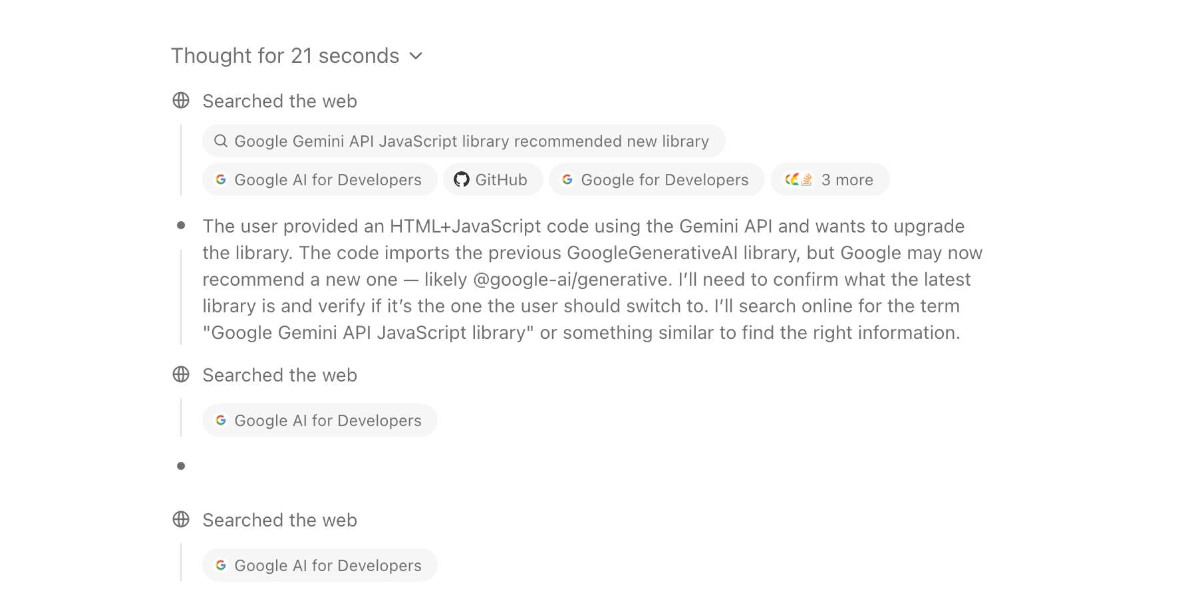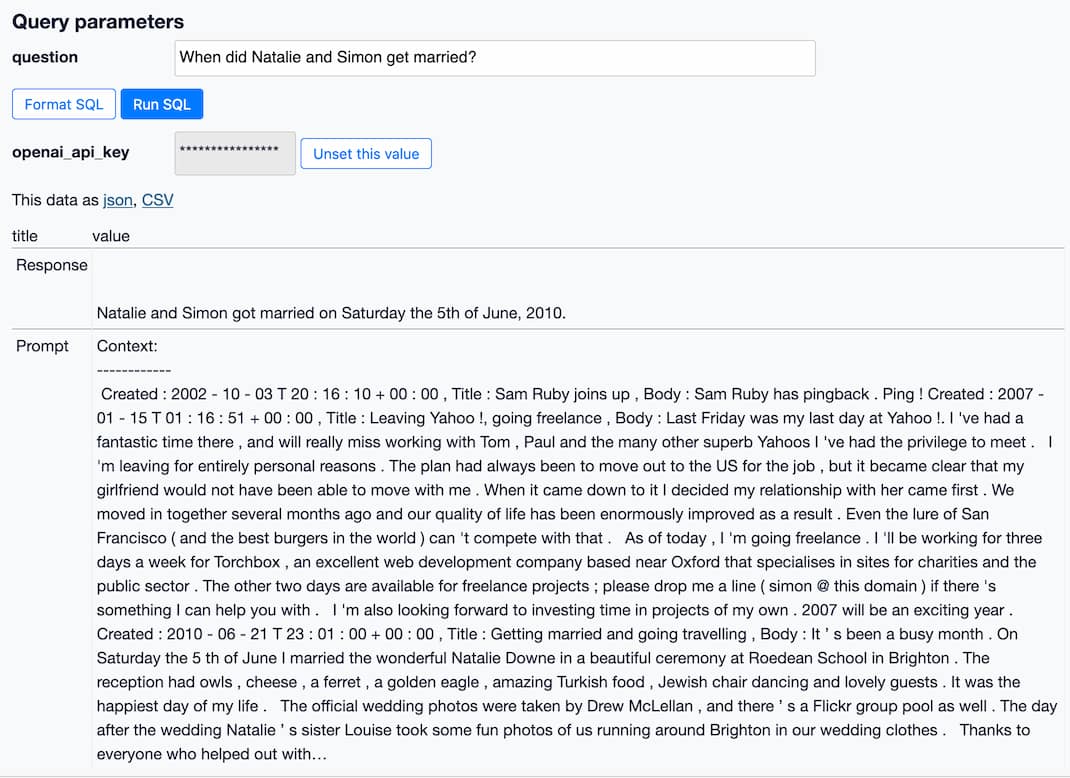93 posts tagged “search”
2025
When I wrote about how good ChatGPT with GPT-5 is at search yesterday I nearly added a note about how comparatively disappointing Google's efforts around this are.
I'm glad I left that out, because it turns out Google's new "AI mode" is genuinely really good! It feels very similar to GPT-5 search but returns results much faster.
www.google.com/ai (not available in the EU, as I found out this morning since I'm staying in France for a few days.)
Here's what I got for the following question:
Anthropic but lots of physical books and cut them up and scan them for training data. Do any other AI labs do the same thing?
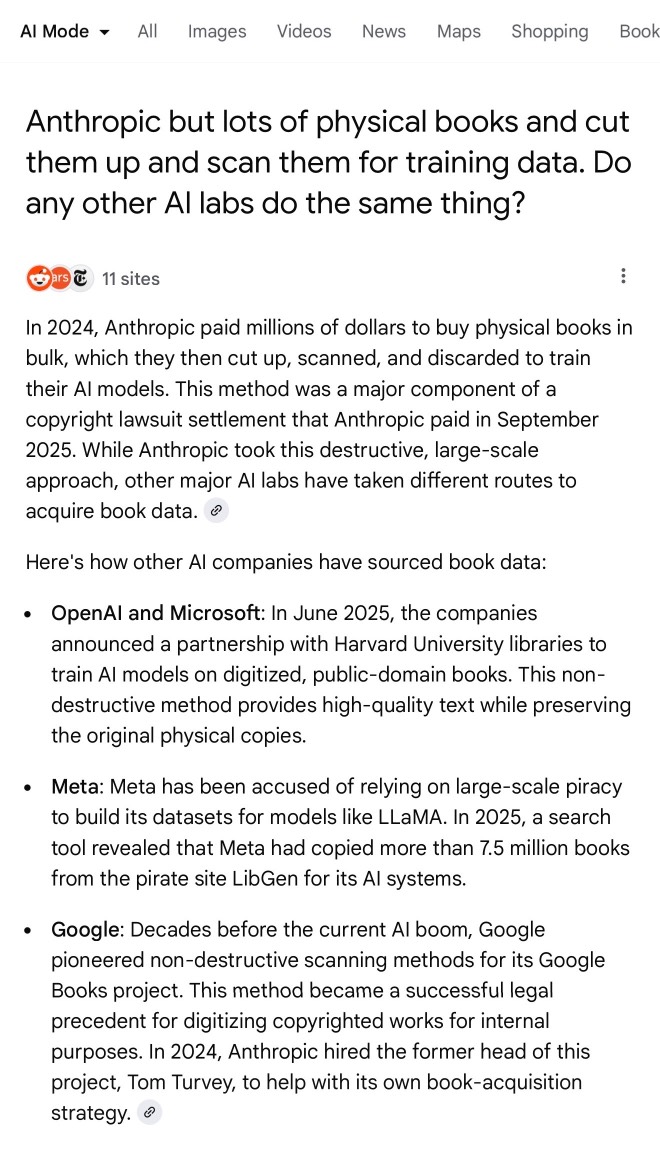
I'll be honest: I hadn't spent much time with AI mode for a couple of reasons:
- My expectations of "AI mode" were extremely low based on my terrible experience of "AI overviews"
- The name "AI mode" is so generic!
Based on some initial experiments I'm impressed - Google finally seem to be taking full advantage of their search infrastructure for building out truly great AI-assisted search.
I do have one disappointment: AI mode will tell you that it's "running 5 searches" but it won't tell you what those searches are! Seeing the searches that were run is really important for me in evaluating the likely quality of the end results. I've had the same problem with Google's Gemini app in the past - the lack of transparency as to what it's doing really damages my trust.
GPT-5 Thinking in ChatGPT (aka Research Goblin) is shockingly good at search
“Don’t use chatbots as search engines” was great advice for several years... until it wasn’t.
[... 2,679 words]llm-tools-exa. When I shipped LLM 0.26 yesterday one of the things I was most excited about was seeing what new tool plugins people would build for it.
Dan Turkel's llm-tools-exa is one of the first. It adds web search to LLM using Exa (previously), a relatively new search engine offering that rare thing, an API for search. They have a free preview, you can grab an API key here.
I'm getting pretty great results! I tried it out like this:
llm install llm-tools-exa
llm keys set exa
# Pasted API key here
llm -T web_search "What's in LLM 0.26?"
Here's the full answer - it started like this:
LLM 0.26 was released on May 27, 2025, and the biggest new feature in this version is official support for tools. Here's a summary of what's new and notable in LLM 0.26:
- LLM can now run tools. You can grant LLMs from OpenAI, Anthropic, Gemini, and local models access to any tool you represent as a Python function.
- Tool plugins are introduced, allowing installation of plugins that add new capabilities to any model you use.
- Tools can be installed from plugins and loaded by name with the --tool/-T option. [...]
Exa provided 21,000 tokens of search results, including what looks to be a full copy of my blog entry and the release notes for LLM.
GitHub Issues search now supports nested queries and boolean operators: Here’s how we (re)built it. GitHub Issues got a significant search upgrade back in January. Deborah Digges provides some behind the scene details about how it works and how they rolled it out.
The signature new feature is complex boolean logic: you can now search for things like is:issue state:open author:rileybroughten (type:Bug OR type:Epic), up to five levels of nesting deep.
Queries are parsed into an AST using the Ruby parslet PEG grammar library. The AST is then compiled into a nested Elasticsearch bool JSON query.
GitHub Issues search deals with around 2,000 queries a second so robust testing is extremely important! The team rolled it out invisibly to 1% of live traffic, running the new implementation via a queue and competing the number of results returned to try and spot any degradations compared to the old production code.
Introducing web search on the Anthropic API
(via)
Anthropic's web search (presumably still powered by Brave) is now also available through their API, in the shape of a new web search tool called web_search_20250305.
You can specify a maximum number of uses per prompt and you can also pass a list of disallowed or allowed domains, plus hints as to the user's current location.
Search results are returned in a format that looks similar to the Anthropic Citations API.
It's charged at $10 per 1,000 searches, which is a little more expensive than what the Brave Search API charges ($3 or $5 or $9 per thousand depending on how you're using them).
I couldn't find any details of additional rules surrounding storage or display of search results, which surprised me because both Google Gemini and OpenAI have these for their own API search results.
AI assisted search-based research actually works now
For the past two and a half years the feature I’ve most wanted from LLMs is the ability to take on search-based research tasks on my behalf. We saw the first glimpses of this back in early 2023, with Perplexity (first launched December 2022, first prompt leak in January 2023) and then the GPT-4 powered Microsoft Bing (which launched/cratered spectacularly in February 2023). Since then a whole bunch of people have taken a swing at this problem, most notably Google Gemini and ChatGPT Search.
[... 1,618 words]An LLM Query Understanding Service (via) Doug Turnbull recently wrote about how all search is structured now:
Many times, even a small open source LLM will be able to turn a search query into reasonable structure at relatively low cost.
In this follow-up tutorial he demonstrates Qwen 2-7B running in a GPU-enabled Google Kubernetes Engine container to turn user search queries like "red loveseat" into structured filters like {"item_type": "loveseat", "color": "red"}.
Here's the prompt he uses.
Respond with a single line of JSON:
{"item_type": "sofa", "material": "wood", "color": "red"}
Omit any other information. Do not include any
other text in your response. Omit a value if the
user did not specify it. For example, if the user
said "red sofa", you would respond with:
{"item_type": "sofa", "color": "red"}
Here is the search query: blue armchair
Out of curiosity, I tried running his prompt against some other models using LLM:
gemini-1.5-flash-8b, the cheapest of the Gemini models, handled it well and cost $0.000011 - or 0.0011 cents.llama3.2:3bworked too - that's a very small 2GB model which I ran using Ollama.deepseek-r1:1.5b- a tiny 1.1GB model, again via Ollama, amusingly failed by interpreting "red loveseat" as{"item_type": "sofa", "material": null, "color": "red"}after thinking very hard about the problem!
Anthropic Trust Center: Brave Search added as a subprocessor (via) Yesterday I was trying to figure out if Anthropic has rolled their own search index for Claude's new web search feature or if they were working with a partner. Here's confirmation that they are using Brave Search:
Anthropic's subprocessor list. As of March 19, 2025, we have made the following changes:
Subprocessors added:
- Brave Search (more info)
That "more info" links to the help page for their new web search feature.
I confirmed this myself by prompting Claude to "Search for pelican facts" - it ran a search for "Interesting pelican facts" and the ten results it showed as citations were an exact match for that search on Brave.
And further evidence: if you poke at it a bit Claude will reveal the definition of its web_search function which looks like this - note the BraveSearchParams property:
{
"description": "Search the web",
"name": "web_search",
"parameters": {
"additionalProperties": false,
"properties": {
"query": {
"description": "Search query",
"title": "Query",
"type": "string"
}
},
"required": [
"query"
],
"title": "BraveSearchParams",
"type": "object"
}
}A Practical Guide to Implementing DeepSearch / DeepResearch. I really like the definitions Han Xiao from Jina AI proposes for the terms DeepSearch and DeepResearch in this piece:
DeepSearch runs through an iterative loop of searching, reading, and reasoning until it finds the optimal answer. [...]
DeepResearch builds upon DeepSearch by adding a structured framework for generating long research reports.
I've recently found myself cooling a little on the classic RAG pattern of finding relevant documents and dumping them into the context for a single call to an LLM.
I think this definition of DeepSearch helps explain why. RAG is about answering questions that fall outside of the knowledge baked into a model. The DeepSearch pattern offers a tools-based alternative to classic RAG: we give the model extra tools for running multiple searches (which could be vector-based, or FTS, or even systems like ripgrep) and run it for several steps in a loop to try to find an answer.
I think DeepSearch is a lot more interesting than DeepResearch, which feels to me more like a presentation layer thing. Pulling together the results from multiple searches into a "report" looks more impressive, but I still worry that the report format provides a misleading impression of the quality of the "research" that took place.
2024
Google search hallucinates Encanto 2. Jason Schreier on Bluesky:
I was excited to tell my kids that there's a sequel to Encanto, only to scroll down and learn that Google's AI just completely made this up
I just replicated the same result by searching Google for encanto 2. Here's what the "AI overview" at the top of the page looked like:
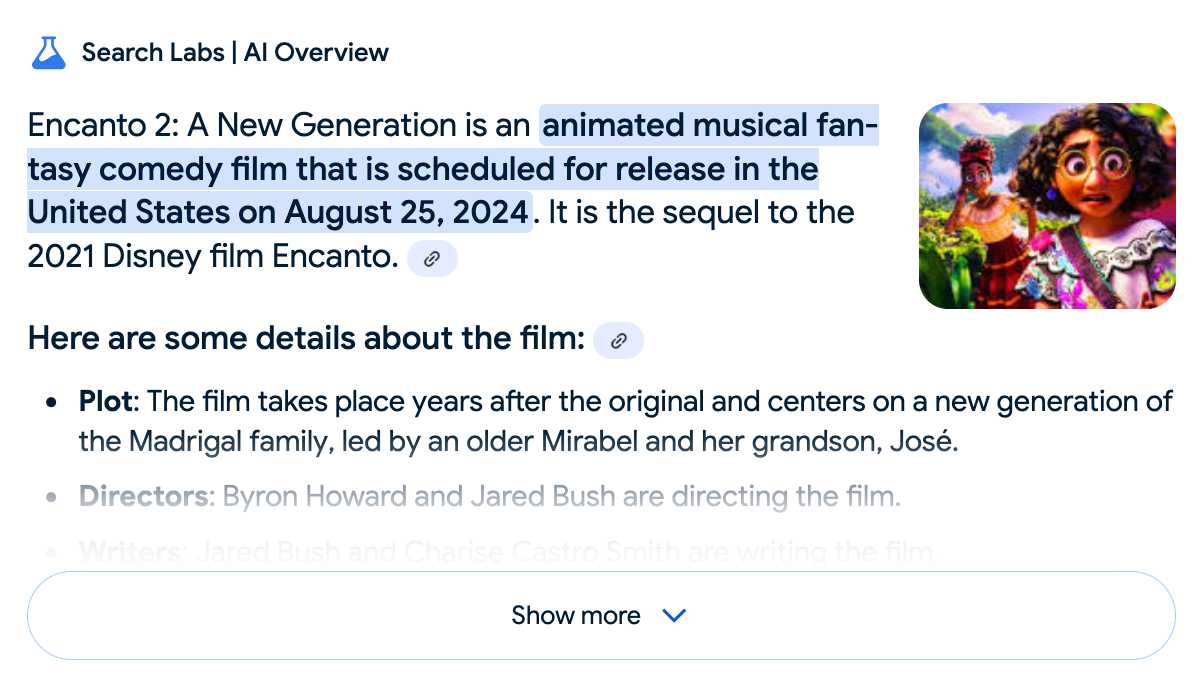
Only when I clicked the "Show more" link did it become clear what had happened:
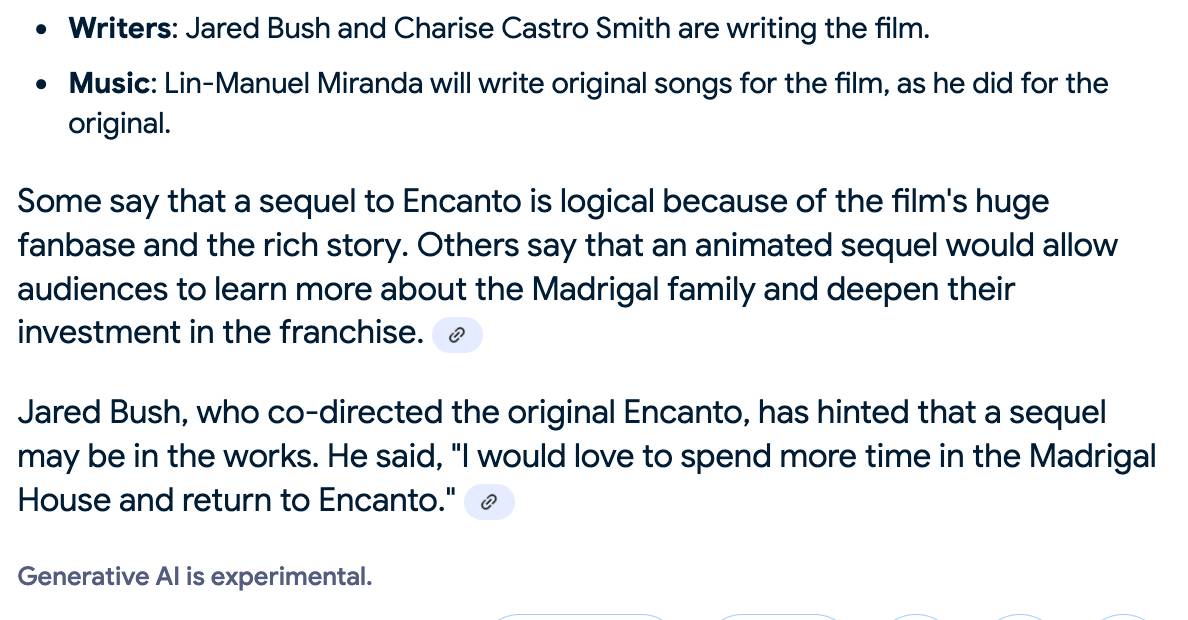
The link in that first snippet was to the Encanto 2: A New Generation page on Idea Wiki:
This is a fanon wiki, and just like fan-fiction wikis, this one has a variety of fan created ideas on here! These include potential sequels and new series that have yet to exist.
Other cited links included this article about Instagram fan art and Encanto's Sequel Chances Addressed by Disney Director, a very thin article built around a short quote from Encanto's director at D23 Brazil.
And that August 2024 release date (which the AI summary weirdly lists as "scheduled for release" despite that date being five months in the past)? It's from the Idea Wiki imaginary info box for the film.
This is a particularly clear example of how badly wrong AI summarization can go. LLMs are gullible: they believe what you tell them, and the web is full of misleading information - some of which is completely innocent.
Update: I've had some pushback over my use of the term "hallucination" here, on the basis that the LLM itself is doing what it's meant to: summarizing the RAG content that has been provided to it by the host system.
That's fair: this is not a classic LLM hallucination, where the LLM produces incorrect data purely from knowledge partially encoded in its weights.
I classify this as a bug in Google's larger LLM-powered AI overview system. That system should be able to take the existence of invalid data sources into account - given how common searches for non-existent movie sequels (or TV seasons) are, I would hope that AI overviews could classify such searches and take extra steps to avoid serving misleading answers.
So think this is a "hallucination" bug in the AI overview system itself: it's making statements about the world that are not true.
Looking back, it's clear we overcomplicated things. While embeddings fundamentally changed how we can represent and compare content, they didn't need an entirely new infrastructure category. What we label as "vector databases" are, in reality, search engines with vector capabilities. The market is already correcting this categorization—vector search providers rapidly add traditional search features while established search engines incorporate vector search capabilities. This category convergence isn't surprising: building a good retrieval engine has always been about combining multiple retrieval and ranking strategies. Vector search is just another powerful tool in that toolbox, not a category of its own.
Understanding the BM25 full text search algorithm (via) Evan Schwartz provides a deep dive explanation of how the classic BM25 search relevance scoring function works, including a very useful breakdown of the mathematics it uses.
If you have worked in search, you know how freaking hard even getting started with something close to this with traditional methods. Now, you can zero-shot it.
System Instructions: As a query categorization expert, you try to break down the intent of a search query. First, provide your reasoning and then describe the intent using a single category (broad, detailed, comparision)
User: The query from the user is "nike versus adidas for terrain running". The user is a female, age 22.Model: The user is clearly looking to compare two specific brands, Nike and Adidas, for a particular activity, terrain running. While the user's demographics might be helpful in some situations (e.g., recommending specific product lines), the core intent remains a comparison. Category: Comparison
There's a lot of hand-waving around query intent classification; it's always been like that. Now, it's straightforward (add a few examples to improve accuracy). But my point is that you could only dream about building something like this without having access to lots of interaction data.
If you want to make a good RAG tool that uses your documentation, you should start by making a search engine over those documents that would be good enough for a human to use themselves.
Hybrid full-text search and vector search with SQLite. As part of Alex’s work on his sqlite-vec SQLite extension - adding fast vector lookups to SQLite - he’s been investigating hybrid search, where search results from both vector similarity and traditional full-text search are combined together.
The most promising approach looks to be Reciprocal Rank Fusion, which combines the top ranked items from both approaches. Here’s Alex’s SQL query:
-- the sqlite-vec KNN vector search results
with vec_matches as (
select
article_id,
row_number() over (order by distance) as rank_number,
distance
from vec_articles
where
headline_embedding match lembed(:query)
and k = :k
),
-- the FTS5 search results
fts_matches as (
select
rowid,
row_number() over (order by rank) as rank_number,
rank as score
from fts_articles
where headline match :query
limit :k
),
-- combine FTS5 + vector search results with RRF
final as (
select
articles.id,
articles.headline,
vec_matches.rank_number as vec_rank,
fts_matches.rank_number as fts_rank,
-- RRF algorithm
(
coalesce(1.0 / (:rrf_k + fts_matches.rank_number), 0.0) * :weight_fts +
coalesce(1.0 / (:rrf_k + vec_matches.rank_number), 0.0) * :weight_vec
) as combined_rank,
vec_matches.distance as vec_distance,
fts_matches.score as fts_score
from fts_matches
full outer join vec_matches on vec_matches.article_id = fts_matches.rowid
join articles on articles.rowid = coalesce(fts_matches.rowid, vec_matches.article_id)
order by combined_rank desc
)
select * from final;I’ve been puzzled in the past over how to best do that because the distance scores from vector similarity and the relevance scores from FTS are meaningless in comparison to each other. RRF doesn’t even attempt to compare them - it uses them purely for row_number() ranking within each set and combines the results based on that.
Introducing Contextual Retrieval (via) Here's an interesting new embedding/RAG technique, described by Anthropic but it should work for any embedding model against any other LLM.
One of the big challenges in implementing semantic search against vector embeddings - often used as part of a RAG system - is creating "chunks" of documents that are most likely to semantically match queries from users.
Anthropic provide this solid example where semantic chunks might let you down:
Imagine you had a collection of financial information (say, U.S. SEC filings) embedded in your knowledge base, and you received the following question: "What was the revenue growth for ACME Corp in Q2 2023?"
A relevant chunk might contain the text: "The company's revenue grew by 3% over the previous quarter." However, this chunk on its own doesn't specify which company it's referring to or the relevant time period, making it difficult to retrieve the right information or use the information effectively.
Their proposed solution is to take each chunk at indexing time and expand it using an LLM - so the above sentence would become this instead:
This chunk is from an SEC filing on ACME corp's performance in Q2 2023; the previous quarter's revenue was $314 million. The company's revenue grew by 3% over the previous quarter.
This chunk was created by Claude 3 Haiku (their least expensive model) using the following prompt template:
<document>
{{WHOLE_DOCUMENT}}
</document>
Here is the chunk we want to situate within the whole document
<chunk>
{{CHUNK_CONTENT}}
</chunk>
Please give a short succinct context to situate this chunk within the overall document for the purposes of improving search retrieval of the chunk. Answer only with the succinct context and nothing else.
Here's the really clever bit: running the above prompt for every chunk in a document could get really expensive thanks to the inclusion of the entire document in each prompt. Claude added context caching last month, which allows you to pay around 1/10th of the cost for tokens cached up to your specified beakpoint.
By Anthropic's calculations:
Assuming 800 token chunks, 8k token documents, 50 token context instructions, and 100 tokens of context per chunk, the one-time cost to generate contextualized chunks is $1.02 per million document tokens.
Anthropic provide a detailed notebook demonstrating an implementation of this pattern. Their eventual solution combines cosine similarity and BM25 indexing, uses embeddings from Voyage AI and adds a reranking step powered by Cohere.
The notebook also includes an evaluation set using JSONL - here's that evaluation data in Datasette Lite.
tantivy-cli (via) I tried out this Rust based search engine today and I was very impressed.
Tantivy is the core project - it's an open source (MIT) Rust library that implements Lucene-style full text search, with a very full set of features: BM25 ranking, faceted search, range queries, incremental indexing etc.
tantivy-cli offers a CLI wrapper around the Rust library. It's not actually as full-featured as I hoped: it's intended as more of a demo than a full exposure of the library's features. The JSON API server it runs can only be used to run simple keyword or phrase searches for example, no faceting or filtering.
Tantivy's performance is fantastic. I was able to index the entire contents of my link blog in a fraction of a second.
I found this post from 2017 where Tantivy creator Paul Masurel described the initial architecture of his new search side-project that he created to help him learn Rust. Paul went on to found Quickwit, an impressive looking analytics platform that uses Tantivy as one of its core components.
The Python bindings for Tantivy look well maintained, wrapping the Rust library using maturin. Those are probably the best way for a developer like myself to really start exploring what it can do.
Also notable: the Hacker News thread has dozens of posts from happy Tantivy users reporting successful use on their projects.
How do I opt into full text search on Mastodon? (via) I missed this new Mastodon feature when it was released in 4.2.0 last September: you can now opt-in to a new setting which causes all of your future posts to be marked as allowed to be included in the Elasticsearch index provided by Mastodon instances that enable search.
It only applies to future posts because it works by adding an "indexable" flag to those posts, which can then be obeyed by other Mastodon instances that the post is syndicated to.
You can turn it on for your own account from the /settings/privacy page on your local instance.
The release notes for 4.2.0 also mention new search operators:
from:me,before:2022-11-01,after:2022-11-01,during:2022-11-01,language:fr,has:poll, orin:library(for searching only in posts you have written or interacted with)
But where the company once limited itself to gathering low-hanging fruit along the lines of “what time is the super bowl,” on Tuesday executives showcased generative AI tools that will someday plan an entire anniversary dinner, or cross-country-move, or trip abroad. A quarter-century into its existence, a company that once proudly served as an entry point to a web that it nourished with traffic and advertising revenue has begun to abstract that all away into an input for its large language models.
The challenge [with RAG] is that most corner-cutting solutions look like they’re working on small datasets while letting you pretend that things like search relevance don’t matter, while in reality relevance significantly impacts quality of responses when you move beyond prototyping (whether they’re literally search relevance or are better tuned SQL queries to retrieve more appropriate rows). This creates a false expectation of how the prototype will translate into a production capability, with all the predictable consequences: underestimating timelines, poor production behavior/performance, etc.
More than an OpenAI Wrapper: Perplexity Pivots to Open Source. I’m increasingly impressed with Perplexity.ai—I’m using it on a daily basis now. It’s by far the best implementation I’ve seen of LLM-assisted search—beating Microsoft Bing and Google Bard at their own game.
A year ago it was implemented as a GPT 3.5 powered wrapper around Microsoft Bing. To my surprise they’ve now evolved way beyond that: Perplexity has their own search index now and is running their own crawlers, and they’re using variants of Mistral 7B and Llama 70B as their models rather than continuing to depend on OpenAI.
2023
ast-grep (via) There are a lot of interesting things about this year-old project.
sg (an alias for ast-grep) is a CLI tool for running AST-based searches against code, built in Rust on top of the Tree-sitter parsing library. You can run commands like this:
sg -p ’await await_me_maybe($ARG)’ datasette --lang python
To search the datasette directory for code that matches the search pattern, in a syntax-aware way.
It works across 19 different languages, and can handle search-and-replace too, so it can work as a powerful syntax-aware refactoring tool.
My favourite detail is how it’s packaged. You can install the CLI utility using Homebrew, Cargo, npm or pip/pipx—each of which will give you a CLI tool you can start running. On top of that it provides API bindings for Rust, JavaScript and Python!
Wikipedia search-by-vibes through millions of pages offline (via) Really cool demo by Lee Butterman, who built embeddings of 2 million Wikipedia pages and figured out how to serve them directly to the browser, where they are used to implement “vibes based” similarity search returning results in 250ms. Lots of interesting details about how he pulled this off, using Arrow as the file format and ONNX to run the model in the browser.
Building Search DSLs with Django (via) Neat tutorial by Dan Lamanna: how to build a GitHub-style search feature—supporting modifiers like “is:open author:danlamanna”—using PyParsing and the Django ORM.
GitHub code search is generally available. I’ve been a beta user of GitHub’s new code search for a year and a half now and I wouldn’t want to be without it. It’s spectacularly useful: it provides fast, regular-expression-capable search across every public line of code hosted by GitHub—plus code in private repos you have access to.
I mainly use it to compensate for libraries with poor documentation—I can usually find an example of exactly what I want to do somewhere on GitHub.
It’s also great for researching how people are using libraries that I’ve released myself—to figure out how much pain deprecating a method would cause, for example.
Can We Trust Search Engines with Generative AI? A Closer Look at Bing’s Accuracy for News Queries (via) Computational journalism professor Nick Diakopoulos takes a deeper dive into the quality of the summarizations provided by AI-assisted Bing. His findings are troubling: for news queries, which are a great test for AI summarization since they include recent information that may have sparse or conflicting stories, Bing confidently produces answers with important errors: claiming the Ohio train derailment happened on February 9th when it actually happened on February 3rd for example.
Bing: “I will not harm you unless you harm me first”
Last week, Microsoft announced the new AI-powered Bing: a search interface that incorporates a language model powered chatbot that can run searches for you and summarize the results, plus do all of the other fun things that engines like GPT-3 and ChatGPT have been demonstrating over the past few months: the ability to generate poetry, and jokes, and do creative writing, and so much more.
[... 4,922 words]The technology behind GitHub’s new code search (via) I’ve been a beta user of the new GitHub code search for a while and I absolutely love it: you really can run a regular expression search across the entire of GitHub, which is absurdly useful for both finding code examples of under-documented APIs and for seeing how people are using open source code that you have released yourself. It turns out GitHub built their own search engine for this from scratch, called Blackbird. It’s implemented in Rust and makes clever use of sharded ngram indexes—not just trigrams, because it turns out those aren’t quite selective enough for a corpus that includes a lot of three letter keywords like “for”.
I also really appreciated the insight into how they handle visibility permissions: they compile those into additional internal search clauses, resulting in things like “RepoIDs(...) or PublicRepo()”
How to implement Q&A against your documentation with GPT3, embeddings and Datasette
If you’ve spent any time with GPT-3 or ChatGPT, you’ve likely thought about how useful it would be if you could point them at a specific, current collection of text or documentation and have it use that as part of its input for answering questions.
[... 3,447 words]2022
Semantic text search using embeddings. Example Python notebook from OpenAI demonstrating how to build a search engine using embeddings rather than straight up token matching. This is a fascinating way of implementing search, providing results that match the intent of the search (“delicious beans” for example) even if none of the keywords are actually present in the text.

